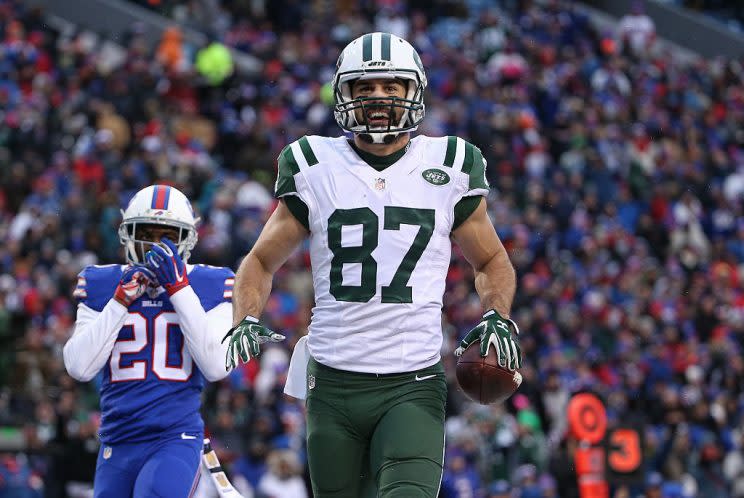Juggernaut Index, No. 10: The New York Jets

The Juggernaut Index is our annual ranking and review of NFL teams for fantasy purposes — repeat: FANTASY PURPOSES. Here we concern ourselves with a franchise’s likely contributions to the fantasy player pool. We are not concerned with projected wins and losses. Instead, we’re focused on yards and points. As always, we’re beginning with the league’s least useful teams, working our way toward the elite fantasy juggernauts.
[Join a Yahoo Fantasy Football league for free and make 2016 your season!]
When Ryan Fitzpatrick re-upped with New York back in July, it was a huge win for Jets fans, for fantasy owners, and for those of us who produce NFL team previews. I can tell you from past experience that it’s no fun to forecast (or even consider) a Geno Smith-led offense. Fitzpatrick clearly has his flaws — he completed just 59.6 percent of his throws last season — but he’s at least competent by NFL standards. He can direct scoring drives with a level of consistency not yet achieved by Geno, and with only minimal hilarity. With Fitz back at the controls, we can feel good about this team’s potential for fantasy goodness.
Fitzpatrick established new career highs in both passing yards (3905) and touchdowns (31) last season, and he was sacked only 19 times on 581 drop-backs. Of course he also closed the year with a three-interception performance at Buffalo, preventing the Jets from clinching a postseason berth. There’s the good sort of FitzMagic, and then there’s a darker, more sinister variety — like with Jedis and Siths.
In any case, Fitzpatrick delivered a quality fantasy season in Chan Gailey’s offense and he’s back for another year, working with an excellent (though top-heavy) receiving corps. He’s best viewed as a QB2 in our game, a platoon option in standard formats and viable starter in 16-team leagues. He’s a low-cost option in a very good situation. Bryce Petty is pushing Smith for the No. 2 role, with rookie Christian Hackenberg buried on the preseason depth chart, receiving minimal reps. No need to draft anyone mentioned in the previous sentence, in any fantasy format.
Brandon Marshall and Eric Decker absolutely dominated the opportunities and touchdowns in New York’s passing game last season, to a ridiculous extent. Those two combined for 305 targets, while no other Jets wideout saw more than Quincy Enunwa’s 46. Marshall and Decker also accounted for 26 of this team’s 33 passing scores. Entering 2016, Marshall again rates as a no-doubt No. 1 receiver for fantasy purposes, a solid second-rounder in most leagues, and Decker is a reliable No. 2. Very few players in recent memory have been as weirdly consistent over the course of a full season as Decker was last year. In his worst fantasy performance of 2015, he still caught four passes for 81 yards. Decker managed to find the end-zone in 12 of his 15 games, yet never gave us a two-TD performance.
I shouldn’t need to tell you that when two exceptional receivers are hogging all the targets, very few statistical scraps remain for anyone else. Devin Smith is returning from a late-season ACL injury, so he’s not on the fantasy radar at present. This team’s depth chart at tight end is like a discard pile of former fantasy sleepers: Jace Amaro, Kellen Davis, Zach Sudfeld, Brandon Bostick. I urge you to ignore ’em all.

The Jets lost free agent running back Chris Ivory to the Jaguars back in March, but the team added 30-year-old Matt Forte at a friendlier salary. Forte is stylistically different from Ivory, obviously, and he probably won’t be called upon to carry the ball more than, say, 210 times. He’s not a pounder, but he remains a highly skilled dual-threat backfield weapon, likely to catch 40-50 passes and deliver 1300 scrimmage yards in a healthy season. Consider him a respectable RB2; let’s hope you don’t have to pay an RB1 price. Bilal Powell remains in the mix as a rotational back — something more than a handcuff and less than an every-week flex. He’s a better bet in PPR leagues, coming off a 47-catch season. Khiry Robinson will poach goal-line carries, but he shouldn’t threaten Forte or Powell in any other area. Historically, Forte has struggled on inside-the-5 rush attempts, so it’s not as if fantasy owners were expecting double-digit spikes from the vet.
New York’s defense was a quality unit in reality last season, allowing just 19.6 points per game and ranking second in the league against the run (83.4 YPG, 3.6 YPC). As a fantasy asset, however, the Jets D was merely adequate. The team’s lack of defensive TDs was a killer in fantasy terms. Still, New York features difference-makers at each level — Wilkerson, Harris, Revis, Pryor — and this D deserves draft-day consideration.
—
2015 Offensive Stats & Ranks
Points per game – 24.2 (11)
Pass YPG – 253.6 (13)
Rush YPG – 116.8 (10)
Yards per play – 5.5 (13)
Plays per game – 67.1 (6)
—
Previous Juggernaut Index entries: 32) Cleveland, 31) San Francisco, 30) Philadelphia, 29) Baltimore, 28) Tennessee, 27) Los Angeles, 26) Miami, 25) Detroit, 24) Chicago, 23) San Diego, 22) Minnesota, 21) Tampa Bay, 20) Atlanta, 19) Washington, 18) Buffalo, 17) Kansas City, 16) Oakland, 15) NY Giants, 14) Indianapolis, 13) Jacksonville, 12) Houston, 11) Denver, 10) NY Jets

 Yahoo Sports
Yahoo Sports 

